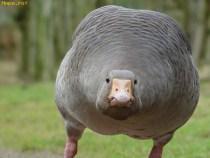
Honk
Christmas is coming,
The goose is getting fat;
Please put a penny
In the old man’s hat.
If you haven’t got a penny,
A ha’penny will do;
If you haven’t got a ha’penny
God bless you.
This rhyme, often sung as a round, doesn’t appear in " target="_blank">the nursery rhyme addict’s bible, which makes dating it difficult. On first inspection it feels very Victorian, but the text offers few real clues to support this.
Charitable giving, while certainly part of the Victorian myth of Christmas, is a concept that dates at least back to the Middle Ages and the feast of St Stephen which is celebrated in the carol ‘Good King Wenceslas‘. Likewise, mention of the penny and ha’penny only mean that the rhyme cannot have been written before the reign of Henry I.
Goose for dinner
Goose has graced the table at ritual feasts since time immemorial, though it has gone in and out of fashion. The Celts served goose at Samhain and medieval Christians served it at Michealmas (29th September) but the tradition of eating the fowl at Christmas may come from the Germanic festival of Yule.
By Elizabethan times, goose was expensive. Nevertheless, it remained traditional at least among those who could afford it (those who couldn’t would generally adhere to whatever the local regional tradition was). In 1588, Elizabeth I ordered her subjects to eat goose for their Christmas dinner in a celebration of England’s victory over the Armada, which likely added to its popularity.
Cromwellian and Restoration Christmases were a subdued affair, but by the Victorian era goose was back on the menu. Prince Albert may have made turkey the fashionable choice, but for the poor, only one bird would do:
… you might have thought a goose the rarest of all birds; a feathered phenomenon, to which a black swan was a matter of course – and in truth it was something very like it in that house.
[...]
There never was such a goose. Bob said he didn’t think there ever was such a goose cooked. Its tenderness and flavour, size and cheapness, were themes of universal admiration. Eked out by apple-sauce and mashed potatoes it was a sufficient dinner for the whole family indeed; as Mrs Cratchit great delight (surveying one small atom of a bone upon the dish), they hadn’ t ate it all at last! Yet every one had had enough, and the youngest particular, were steeped in sage and onion to the eyebrows!
Dickens’ A Christmas Carol, pp. 55-56
Music & Lyric
If the eating of goose at Christmas is more prevalent in Elizabethan & Victorian periods, it’s likely the rhyme was first penned during one of those periods. Given the syntax and language of the I’d put my money on the rhyme being written significantly post 1800. This is supported by the rhymes lack of inclusion in anthologies like Gammer Gurton’s Garland or Nursery Rhymes of England, published in 1866 and 1849 respectively.
The first publication of ‘Christmas is Coming’ that I can find is in the 1883 book by CS Burne and GF Jackson entitled Shropshire Folklore. The rhyme appears under the heading of Nursery Rhymes and Children’s Jingles and is noted as having been collected in Oswestry.
It is often suggested that Edith Nesbit Bland (1858-1924), better known for her novel The Railway Children, composed the music to which the rhyme is set, but I cannot find a source to confirm this*. Whomever composed the music, the sung rhyme was popularised by the Kingston Trio when it was included (as A Round about Christmas) on their 1960 album The Last Month of the Year. The liner notes of the album claim that the rhyme is often sung while a hat is passed around to collect donations.
Nineteen years later, an even more unlikely artist released a version of the song on the album A Christmas Together. Here’s John Denver and the Muppets:
Whenever the rhyme was written, whomever added the melody, ‘Christmas is Coming’ remains a seasonal favourite. The words remind us that, as we prepare to spend the holiday season in celebration, we should spare a thought (and a coin if we can) for those who are less fortunate than us. That’s the sort of sentiment most of us can get behind.
————————————————————————————————-
* A North American book from 1945, Sing and Dance: Folk Songs and Dances including Play-party Games, names Nesbit of the author of the lyric and melody. Since we know she’s definitley not responsible for the lyric it’s hard to trust the suggestion that she’s responsible for the tune.
